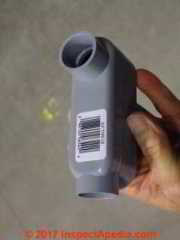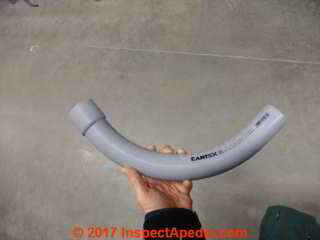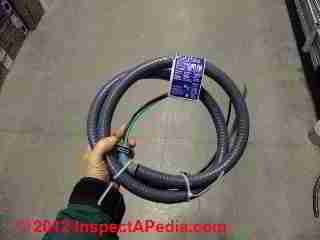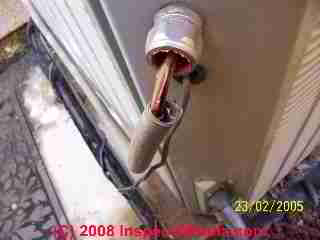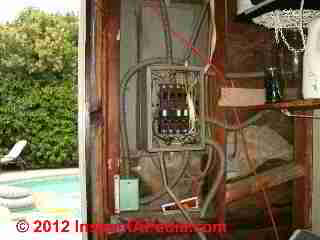 Non-Metallic Electrical Conduit Types
Non-Metallic Electrical Conduit Types
Plastic, ENT & LFNC electrical conduit
- POST a QUESTION or COMMENT about how to buy, bend, wire, & install electrical conduit in buildings
Here we describe the various types & applications of ENT or LNFC (liquid tight) non-metallic electrical conduit made of plastic, PVC.
This article series describes both metallic electrical conduit and plastic or non-metallic electrical conduit products, and answers basic questions about installing electrical conduit. Electrical conduit is metal or plastic rigid or flexible tubing used to route electrical wires in a building.
The page top photo showing conduit used to bring wires up to an electrical sub-panel was provided courtesy of Tim Hemm.
InspectAPedia tolerates no conflicts of interest. We have no relationship with advertisers, products, or services discussed at this website.
- Daniel Friedman, Publisher/Editor/Author - See WHO ARE WE?
ENT Electrical, Non-Metallic Conduit: Rigid & Flexible Plastic Electrical Conduit

Plastic electrical conduit or rigid PVC-U pipe specified as electrical nonmetallic tubing (ENT) conduit, shown in our photographs here, is easier to cut than metallic conduit products.
Flexible plastic conduit is also sold as LFNC, liquid-tight nonmetallic conduit.
Plastic conduit can be heated and bent to non-standards shapes, or pre-formed bends and elbows can be used.
Watch out: do not mix types of cements (glues) used with plastic water or drain piping with conduit cement.
Conduit cement is not suitable for piping and fittings subjected to pressure.
Use proper fittings to join and terminate rigid plastic conduit tubing, and protect it from damage too.
Our photo shows Cantex® Schedule D Rigid PVC non-metallic Electrical Conduit in a Home Depot store. [Click to enlarge any image]
ENT conduit sections and fittings are joined by conduit solvent cement specifically formulated for use with PVC (polyvinyl chloride) plastic conduit ducts and fittings.
Spacing & Support for Rigid PVC Electrical Conduit
Table 352.30(B) NEC shows the support requirements for Schedule. 40 & Schedule 80 PVC electrical conduit
- Rigid PVC electrical conduit at 1/2" - 1" in diameter, maximum space between supports: 3 ft.
- Rigid PVC electrical conduit 1 1/4" - 2" in diameter, maximum space between supports: 5 ft.
- Rigid PVC electrical conduit 2 1/2" - 3" in diameter, maximum space between supports: 6 ft.
- Rigid PVC electrical conduit 3 1/2" - 5" in diameter, maximum space between supports: 7 ft.
- Rigid PVC electrical conduit 6" in diameter, maximum spacing between supports: 7 ft.
Notes on using PVC electrical conduit:
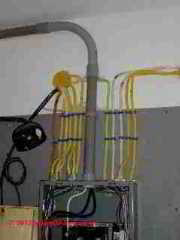 Total weight of conduit including wires enclosed may be a factor in the requirements for conduit support
Total weight of conduit including wires enclosed may be a factor in the requirements for conduit support
PVC electrical conduit (PVC-U) in the U.S. is sold in sizes from 1/2" to 8" in diameter and in three formulations: EPT-A-PVC, EPC-40-PBC, and EPC-80-PVC.
Plastic conduit should always be installed away from steam lines and other high heat sources.
PVC electrical conduit support straps should allow for lineal movement caused by expansion and contraction.
Maximum ambient temperature exposure for PVC electrical conduit is 122°F (50°C)
Our photo shows rigid PVC or ENT used to bring power to a sub panel being installed in the author's garage.
[Click to enlarge any image]
Rigid PVC Electrical Conduit Code & Standards & Sources:
- U.S. National Electrical Code, Table 352.30(B)
- Carlon Corporation, "Rigid Nonmetallic Conduit - Schedule 40, Carlon Rigid Nonmetallic Conduit (RNC), Fittings & Accessories", Gross Automation 3680 N. 126th St. Brookfield, WI 53005 USA, Tel: 877-268-3700, Website: Carlonsales.com, Email: sales@grossautomation.com - retreived 8 Sept 2015 original source: http://www.carlonsales.com/techinfo/brochures/conduit/Conduit_Schedule_40_and_80.pdf
- RIGID CONDUIT INSTALLATION GUIDELINES [PDF], Royal Electrical Solutions, 56400 Mound Road - Shelby Twp., MI 48316 USA, Tel: 1.800.232.5690 Website: royalbuildingproducts.com
Question: with 3/4" schedule 40 pvc, is the ground considered a support?
(Sept 28, 2016) Bert Deaton said:
When coming our of the ground with 3/4" schedule 40 pvc, is the ground considered a support? I have some 30" conduits that I am being told by the general I need to put strut and straps on. They go 30" from the ground to inverters. I can not find in the code book where the ground is considered a support. Thanks for any help.
Reply:
Bert:
3/4" PVC electrical conduit support spacing requirements depend on the rated operating temperature as follows:
3/4" PVC conduit at 60 degF can be supported on 5 ft. intervals
3/4" PVC conduit at 100 degF can be supported on 4 ft. intervals
3/4" PVC conduit at 140 degF can be supported on 2 1/2 ft. intervals.
I agree with you that conduit coming out of the earth might appear to be "supported" by the soil, but since soil itself can vary in hardness as water or other conditions change, I can also see why the supervising contractor thinks you need a support right at that location.
Here is a typical instruction from a PVC Conduit supplier:
"Rigid PVC conduit must be supported with straps when installed in above ground applications. These straps should be installed snugly, while allowing linear movement of the conduit. " - M Royal Electrical Solutions Co., 56400 Mound Road - Shelby Twp., MI 48316 USA, original source: www.royalbuildingproducts.com/uploadedFiles/Pipe_Microsite/Content/Products/Electrical/Rigid_Conduit_Fittings/Rigid%20PVC%20Conduit%20Installation%20Guide.pdf
The company continues, citing the NEC, 3 ft. support intervals. i.e. greater than your 30" distance. Typically support is required also within 36" of any terminus such as an electrical box or in your case to the inverter.
Note that the expert source says "above ground".
Unfortunately, the only way to close the argument about who's going to accept "earth" as a point of support is your local electrical inspector. What does he or she say?Ask also if the inspector accepts Schedule 40 below and emerging from ground. You might also see what expert Mike Holt has to say - see http://forums.mikeholt.com/
Watch out: depending on your jurisdiction, you could be asked to use metal conduit or Schedule 80 PVC below ground & at ground emergence up for some height so as to be protected from people digging about with a shovel or hit by a lawnmower.
Check out NEC '05 230.50(A)& (B) and also see (National Electrical Code 2014)
Article 352 - Rigid Polyvinyl Chloride Conduit: Type PVC
II. Installation
352.10 Uses Permitted. The use of PVC conduit shall be permitted in accordance with 352.10(A) through (H).
(F) Exposed. PVC conduit shall be permitted for exposed work. PVC conduit used exposed in areas of physical damage shall be identified for the use.
(G) Underground Installations. For underground installations, homogenous and nonhomogenous PVC shall be permitted for direct burial and underground encased in concrete. See 300.5 and 300.50.
Article 352 accepts use of Schedule 80 PVC electrical conduit where exposed and subject to physical damage
Article 352 accepts use of Schedule 40 PVC electrical conduit in exposed areas not subject to physical damage (provided you've selected the proper, listed PVC type for your application)
Article 300 - Wiring Methods
I. General Requirements
300.5 Underground Installations.
(D) Protection from Damage. Direct-buried conductors and cables shall be protected from damage in accordance with 300.5(D)(1) through (D)(4).
(4) Enclosure or Raceway Damage. Where the enclosure or raceway is subject to physical damage, the conductors shall be installed in rigid metal conduit, intermediate metal conduit, Schedule 80 PVC conduit, or equivalent.
Electricians also cite
UL 651
Schedule 40, 80, Type EB and A Rigid PVC Conduit and Fittings
1.2 Schedule 40 and 80 conduit and fittings
1.2.1 Schedule 40 rigid PVC conduit and fittings are for aboveground use indoors or outdoors exposed to sunlight and weather, and for underground use by direct burial or encasement in concrete. Schedule 40 rigid PVC conduit, elbows, that are specifically marked for underground use are suitable for use underground only by direct burial or encasement in concrete.
ENT & LFNC Liquid-Tight Non-Metallic Flexible Conduit - Flexible Plastic Conduit
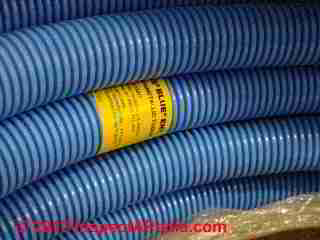

The corrugated flexible plastic electrical conduit is illustrated in our photograph of blue tubing is blue 3/4" Flex-Plus® Carlon Blue® ENT (Electrical Nonmetallic Tubing).
Readers unfamiliar with the alphabet soup of types of electrical conduit will note that "ENT" or Electrical, Non-metallic Tubing used for conduit is thus sold in both rigid ENT and flexible ENT forms, and within flexible ENT are special whips that are waterproof or weatherproof, as we will describe below.
Flexible ENT suffers the nickname of "Smurf Tube" because of its blue color. For readers who haven't met the Smurfs, the blue Smurf shown above is discussed in Wikipedia entries and at other sources.
In residential applications in North America this electrical conduit is used
- in attics up to three feet above the bottom of ceiling joists.
- in basements or cxrawl spaces where moisture in building interiors is a concern
Sections and fittings are joined with PVC cement using a brush (not a dauber).
Watch out: flexible ENT is not permitted in all jurisdictions, and it is not used for exposed electrical work (with a few exceptions).
LFMC: Liquid Tight Flexible Metallic Conduit Whips, Pre-Wired
In nearly all new installations the electrician uses a pre-wired liquid tight electrical conduit whip (photo above) to connect outdoor electrical equipment exposed to the weather, such as an air conditioner or heat pump compressor/condenser unit.
Shown is a six-foot 3-wire Carlton Carflex™ whip assembly produced by Thomas & Betts. [5]
[Click to enlarge any image]
For special applications such as shown in our sketch (below), flexible conduit is often used for convenience or to avoid vibration problems, but steps must be taken to prevent water from entering the conduit and/or special water-resistant wiring and fittings are required.

Pre-wired whips in residential applications (photo above right) are found connecting air conditioner & heat pump compressor units to their outside power source. There the flexible whip avoids problems with vibration-loosened connections in the conduit.
Electrical whips are also used for connecting spas and swimming pool equipment.
Watch out: Flexible conduit and whips are "flexible" but not to degrees that exceed the laws of physics and the properties of the materials.
If you force flexible conduit or a pre-wired conduit whip to bend too acutely over too short a radius such as at its connection to a rigid surface the conduit will eventually break, as Tim Hemm's photograph (left) illustrates.
LFMC Resources
- Carlton Carflex™ whip
- Liquid-Tuff™ Liquid Tight FLex Metallic Conduit, Steel, PVC-jacketed Conduit, 3/8 in Through 1 1/4 in Trade Sizes are Square Lock Formed; Include an Integral Bonding Strip of Copper that is Enclosed Within the Convolutions Throughout their Entire Length, WEEE Compliant; UL-360; ANSI; CSA LL18858; UL E29278
Product Description:
For corrosive environments involving water or other liquids, choose liquid-tight flexible conduit (LFMC). When paired with the appropriate fittings (sold separately), this jacketed conduit provides a liquid-tight seal even as it bends and curves and can be used in direct burial, concrete, and lighting applications.
When environments where liquids, temperature, gas, and combustion are a concern, this harsh environment liquid-tight flexible metallic conduit is the solution. It has a PVC jacket for protection in interior and exterior locations, including direct burial and concrete. - retrieved 2017/08/08 from Grainger
Watch out: Do not attempt to work on your electrical wiring, switches, or outlets unless you are properly trained and equipped to do so. Electrical components in a building can easily cause an electrical shock, burn, or even death.
Even when a hot line switch is off, one terminal on the switch is still connected to the power source.
Before doing any work on the switch, the power source must be turned off by setting a circuit breaker to OFF or removing a fuse.
See SAFETY for ELECTRICAL INSPECTORS
and ELECTRICAL WIRING BOOKS & GUIDES
...
Reader Comments, Questions & Answers About The Article Above
Below you will find questions and answers previously posted on this page at its page bottom reader comment box.
Reader Q&A - also see RECOMMENDED ARTICLES & FAQs
On 2017-01-01 by (mod) Can I run the new wires in PVC conduit that is clamped to the attic floor?
Stan
Your local electrical inspector is the final authority.
I'd prefer to see the conduit mounted under the roof or along a wall, or if along a floor, that it be kept out of walking areas.
On 2016-12-29 by Stan
I want to add some ceiling lights to a bedroom that is beneath a storage attic with a plywood floor. Fishing the wires under the floor is impossible because of the direction of the joists. Can I run the new wires in PVC conduit that is clamped to the attic floor?
Question: using NMC vs Conduit in a Garage
(May 5, 2014) BBaker said:
I have a CMU (concrete masonry unit) garage and I'm installing two new receptacles, branching from a pre-existing outlet (soon to become an outlet and a junction for the two branches). I recently bought 150 feet of NM cable for the rest of the house and was planning to use it in the garage for my branches.
My questions are (prioritized)...
1: "Can NM 12-3 be run through conduit (of any type) without issue, and without raising a flag during a home inspection?"
2: "I know its good practice but, do I need to run conduit at all? If not... then whats the best way to secure the NM wire to the concrete wall?"
3: "The prexisting outlet that I'm wiring my branches from, rests beneath a wooden plank where the NM is exposed, but stapled to the plank, leading into the attic space above the garage and over to my breaker panel. Is this a safe practice? Or should I find a way to protect that cable as well?
Any help would be greatly appreciated. Thanks.
Reply:
BB
I have to give what amounts to a partial answer = opinion.
I have seen NMC run through conduit but that is not a listed, nor approved installation. The intended use and rating for NMC presumes that it is not routed inside of a small-diameter conduit.
Using wire in a manner other than approved is a potential safety hazard regardless of whether or not a particular home inspector happens to pick up that detail.
U-clamps can secure NM cable to a surface but with some work as you'll be drilling into the masonry to mount them. A nice short-cut might be to use Tapcons instead of lead anchors to screw the clips to the wall. That would greatly speed the process and be quite secure.
I don't understand question 3. If you mean that wiring is exposed where it may be walked-on, clearly that's not proper practice.
Question: electrical conduit on the property boundary
Mary Ellen said:
A neighbour has run wiring in an electrical conduit within their boundary but on my side of the fence, under the fence rails. Is this legal?
Reply:
Mary Ellen, this is an interesting question and not one of electrical code or even safe wiring practices, but rather one for your local building department about property line setback requirements.
Those requirements vary by country as well as local jurisdiction, and vary further by types of construction involved.
For example where property lines are *very* close between neighbors, attached townhouses, electrical wiring and other building features must respect fire safety codes.
Quoting from an Australian building code example:
To minimise the spread of fire, fire growth as well as safety of occupants in the event of a fire a building must be constructed so as to satisfy the requirements of:
Part 3.7 of the Building Code of Australia - Housing Provisions (Volume 2) AS4072.1 and AS1530.4 with regard to fire stopping service penetrations.
Manufacturer’s Specification to ensure that the product performs as tested. - retrieved 5/12/14 original source www.bradfordinsulation.com.au/Regulations/BCAFire/Class1a.aspx
In other jurisdictions, the authority may specify that even fences must be kept a specified distance back from the exact property boundary. - retrieved 5/12/14 www.capetown.gov.za/en/Planningportal/Documents/Boundary% 0Walls%20%20Fences%20Policy_Final.pdf)
This sort of wiring constraint does not sound as if it applies to your case as I think you're describing outdoor property.
You don't state your country, city, state, so we don't have an idea what your local rules may require.
I suggest taking the question and your concern to your local building or zoning department for a specific answer.
Question: Can a contractor's plumber install electrical conduit as well?
(July 11, 2016) Ray Rodriguez said:
Can a contractor's plumber install electrical conduit as well? I ask because my contractor's plumber installed the plumbing for my pool, bending PVC with open torch flame and he used same flame torch to bend electrical conduit. I believe that code does not allow bending of PVC (both water & electrical) using an open flame?
Reply:
Who can do what and what licenses are required is a local code jurisdiction question.
Generally licensed plumbers do not perform electrical wiring: it's a separate qualification and license and separte codes apply.
For example in some locales only a licensed electrician can install electrical wiring while in others someone else may be allowed to do it provided that the local electrical inspector is called in at appropriate times to inspect and approve the work. Give your building department a call and ask for help.
...
Continue reading at ELECTRICAL CONDUIT BEND CONNECT TOOLS or select a topic from the closely-related articles below, or see the complete ARTICLE INDEX.
Or see these
Electrical Conduit Types, Applications, Codes, Standards, Sources
- ELECTRICAL CONDUIT, METALLIC - metal conduit
- EMT ELECTRICAL METALLIC CONDUIT - THIN WALLED METAL CONDUIT - rigid
- FMC FLEXIBLE METAL ELECTRICAL CONDUIT - flexible
- IMC INTERMEDIATE METAL CONDUIT, THREADED & NON-THREADED - rigid
- LFMC LIQUID-TIGHT FLEXIBLE METAL CONDUIT & WHIPS - flexible, liquid tight, with wire
- RMC RIGID METAL CONDUIT - rigid
- ELECTRICAL CONDUIT, NON-METALLIC - non-metallic conduit
- ELECTRICAL CONDUIT PULL BOXES
- ENT ELECTRICAL NONMETALLIC TUBING - rigid plastic conduit
- ENT & LFNC NON-METALLIC ELECTRICAL CONDUIT- flexible plastic & liquid-tight flexible plastic conduit
- FLEXIBLE LFNC PRE-WIRED WHIPS - flexible, liquid-tight, with wire
- ELECTRICAL CONDUIT BEND CONNECT TOOLS
- ELECTRICAL CONDUIT DEFECTS & DAMAGE
Suggested citation for this web page
ELECTRICAL CONDUIT, NON-METALLIC at InspectApedia.com - online encyclopedia of building & environmental inspection, testing, diagnosis, repair, & problem prevention advice.
Or see this
INDEX to RELATED ARTICLES: ARTICLE INDEX to ELECTRICAL INSPECTION & TESTING
Or use the SEARCH BOX found below to Ask a Question or Search InspectApedia
Ask a Question or Search InspectApedia
Try the search box just below, or if you prefer, post a question or comment in the Comments box below and we will respond promptly.
Search the InspectApedia website
Note: appearance of your Comment below may be delayed: if your comment contains an image, photograph, web link, or text that looks to the software as if it might be a web link, your posting will appear after it has been approved by a moderator. Apologies for the delay.
Only one image can be added per comment but you can post as many comments, and therefore images, as you like.
You will not receive a notification when a response to your question has been posted.
Please bookmark this page to make it easy for you to check back for our response.
IF above you see "Comment Form is loading comments..." then COMMENT BOX - countable.ca / bawkbox.com IS NOT WORKING.
In any case you are welcome to send an email directly to us at InspectApedia.com at editor@inspectApedia.com
We'll reply to you directly. Please help us help you by noting, in your email, the URL of the InspectApedia page where you wanted to comment.
Citations & References
In addition to any citations in the article above, a full list is available on request.
- [3] Timothy Hemm has provided photographs of various electrical defects used at the InspectAPedia TM Website. Mr. Hemm is a professional electrical inspector in Yucala, CA.
- [4] NFPA - the National Fire Protection Association can be found online at www.nfpa.org
- [5] The 2008 NEC National Electrical Code (ISBN 978-0877657903) Online Access LINK (you'll need to sign in as a professional or as a visitor)
- [6] Thomas & Betts Corporation, Memphis TN, website: www.tnb.com.
- "Electrical System Inspection Basics," Richard C. Wolcott, ASHI 8th Annual Education Conference, Boston 1985.
- "Simplified Electrical Wiring," Sears, Roebuck and Co., 15705 (F5428) Rev. 4-77 1977 [Lots of sketches of older-type service panels.]
- "How to plan and install electric wiring for homes, farms, garages, shops," Montgomery Ward Co., 83-850.
- "Simplified Electrical Wiring," Sears, Roebuck and Co., 15705 (F5428) Rev. 4-77 1977 [Lots of sketches of older-type service panels.]
- "Home Wiring Inspection," Roswell W. Ard, Rodale's New Shelter, July/August, 1985 p. 35-40.
- "Evaluating Wiring in Older Minnesota Homes," Agricultural Extension Service, University of Minnesota, St. Paul, Minnesota 55108.
- In addition to citations & references found in this article, see the research citations given at the end of the related articles found at our suggested
CONTINUE READING or RECOMMENDED ARTICLES.
- Carson, Dunlop & Associates Ltd., 120 Carlton Street Suite 407, Toronto ON M5A 4K2. Tel: (416) 964-9415 1-800-268-7070 Email: info@carsondunlop.com. Alan Carson is a past president of ASHI, the American Society of Home Inspectors.
Thanks to Alan Carson and Bob Dunlop, for permission for InspectAPedia to use text excerpts from The HOME REFERENCE BOOK - the Encyclopedia of Homes and to use illustrations from The ILLUSTRATED HOME .
Carson Dunlop Associates provides extensive home inspection education and report writing material. In gratitude we provide links to tsome Carson Dunlop Associates products and services.


